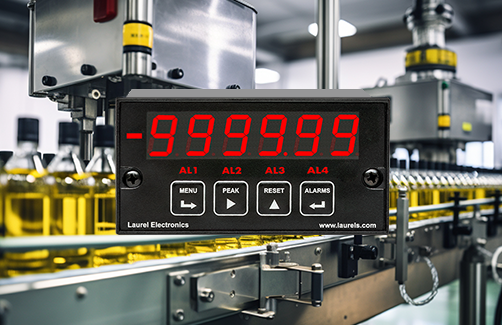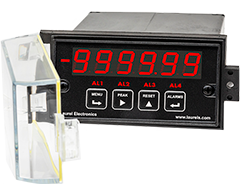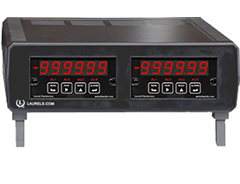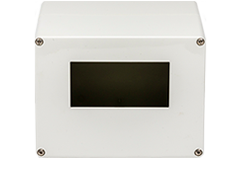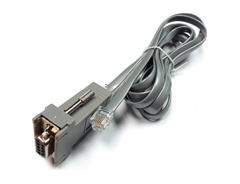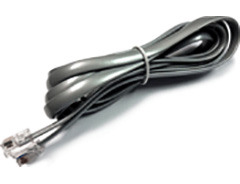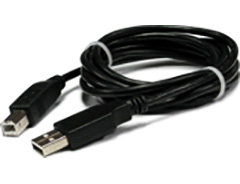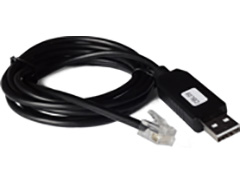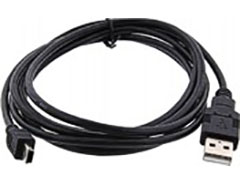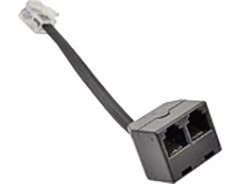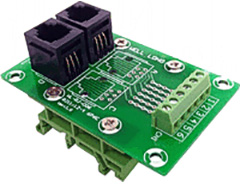- Description
- Specifications
- Setup Software
- Mechanical
- Documents
- Applications
- Technical FAQ
- Accessories
Features
- Provides automatic control for repetitive liquid fill operations
- Available for turbine flow meter pulse signals from 0 Hz to 1 MHz or analog flow meter signals (4-20 mA, 0-1 mA or 0-10V)
- 6-digit scalable display to ±999,999 for batch total, grand total, number of batches, or flow rate
- Counts up from 0 to preset or down from preset to 0
- Two or four control relays for with settable delay between cycles
- Digital span adjust from 0 to ±999,999, zero adjust from -999,999 to +999,999
- Front panel scalable: to ±999,999 for use with current shunts
- 1/8 DIN size with bright red or green 0.56" (14.2mm), high LED digits
- Transducer excitation output, 5, 10, 12, or 24 Vdc (isolated)
- Power 85-264 Vac / 90-300 Vdc or 10-48 Vdc / 12-32 Vac (isolated)
- Operating temperature from -40°C to 70°C (-40°F to 158°F)
- Wide choice of Plug-in-Play options:
- 2 or 4 relays, mechanical or solid state, for alarm or control (isolated)
- 1 or 2 Analog output, 4-20 mA, 0-20 mA, 0-10V, or -10V to +10V (isolated)
- Communications: Ethernet, WiFi, USB, RS232, RS485 (isolated)
The Laureate™ 1/8 DIN Digital Panel Meter batch controller
is a low cost, powerful and highly accurate batching controller for repetitive fill operations. It can use the Laureate FR dual channel pulse input signal conditioner for use with turbine flow meters. Relay control can be provided by two or four 8A contact relays, or by two or four 120 mA AC/DC solid state relays. Fill operations are repeated continually with a programmable delay from 10 ms to 199.99 sec, or based on an external control input.Three items are tracked by the batch control software. These can each be scaled to engineering units of total or flow rate and displayed by the controller's six-digit LED display: Item #1 is the current batch total, which can be set up to count up from zero to a preset limit, or down from a preset limit to zero. Item #2 can be assigned to grand total or number of batches. Item #3 is the flow rate.
Laureate Digital Panel Meters are easily programmed with Laurel’s free Instrument Setup Software, downloadable from our website and compatible with Windows PCs, requiring a data interface board for setup.
All signal conditioner board ranges are factory-calibrated, with calibration factors for each range securely stored in an onboard EEPROM. These factors can be scaled via software to accommodate external shunts, enabling field replacement of signal conditioner boards without necessitating recalibration of the associated digital panel meter. For optimal accuracy, factory recalibration is recommended annually. All Laurel Electronics instruments undergo factory calibration using the industry-leading Fluke calibrators, which are recalibrated yearly and certified traceable to national standards, ensuring the highest level of precision and reliability.
Two or four relays can be used. Relay #1 is assigned to batch total to control the filling operation. Relays #2, #3 and #4 can each be assigned by the user to Items #1, #2 or #3. For example, Relay #2 can be assigned to Item #1 (batch total) with a lower setpoint to serve as a pre-warn and slow down the fill rate near the batch setpoint, and Relay #3 can be assigned to the total number of batches to terminate the batching when a present number of bottles have been filled.
An optional serial communications board allows the batch controller to transmit Items #1, #2 and #3, as well as peak for item #3 (rate). If required, all four items can be displayed simultaneously by augmenting the batch controller with up to three Laureate remote displays. Each of these can have its own analog output and relays for alarm or control.
Batch Control with Turbine Flowmeters
The pulse-input batch controller utilizes the FR dual channel signal conditioner, which accepts pulses from turbine flow meters and most industrial transducers with a pulse output such as proximity switches with PNP or NPN output, TTL or CMOS logic, or magnetic pickup pulses down to 12 mV. The same signal is applied in parallel to the A and B input channels, which are used independently. Either channel can accept pulse rates from 0.005 Hz to 250 kHz, which exceeds the working range of turbine flow meters.
- Channel A is used for totalizing. The measured total is scaled mathematically for control and display of volume in engineering units, such as liters.
- Channel B is used for rate. The pulse frequency is determined by timing an integral number of periods over a specified gate time (plus 30 ms and 0-2 periods), and then taking the inverse of period. The inverse period approach allows much greater accuracy and faster update times than conventional rate meters which count signal pulses over a specified time interval. Update times can be as high as 25/sec. Rate in engineering units, such as liters per second, is obtained by multiplying the input by a scale factor.
- An unfiltered selection provides true peak and valley readings and aids in control applications.
- A batch average filter selection averages each 16 conversions.
- An adaptive moving average filter selection provides a choice of 8 time constants from 80 ms to 9.6 seconds. When a significant change in signal level occurs, the filter adapts by briefly switching to the shortest time to follow the change, then reverts back to its selected time constant. An Auto setting selects the time constant selection based on signal noise.
Peak and valley values are automatically captured. These may be displayed via a front panel pushbutton command or control signal at the rear connector, or be transmitted as serial data.
Two rear panel control Inputs (CMOS/TTL levels, logic 0 = tied to digital ground, logic 1 = open) or dry contacts that can be set to control / activate 14 meter commands.
An (isolated) 5, 10, 12, or 24 Vdc excitation output is standard to power transducers or two-wire transmitters. Ratiometric operation, which automatically compensates for changes in the applied excitation, is jumper selectable for applications, such as bridges, where the signal to be measured is proportional to the excitation level.
Modular Design for Maximum Flexibility at Minimum Cost
All boards are isolated from meter and power grounds. Optional Plug-in-Play boards for communications and control include Ethernet, WiFi, serial communication boards, dual or quad relay boards, and an analog output board. Laureates may be powered from 85-264 Vac or optionally from 12-32 Vac or 10-48 Vdc. The display is available with bright red or green 0.56" (14.2mm) high LED digits. The 1/8 DIN case meets NEMA 4X (IP65) specifications from the front when panel mounted. Any setup functions and front panel keys can be locked out for simplified usage and security. A built-in 5, 10, 12, or 24 Vdc excitation supply can power transducers, eliminating the need for an external power supply. All power and signal connections are via UL / VDE / CSA rated screw clamp plugs.
The Laureate™ Series features modular design with up to 7 isolated plug-in boards, applicable to all Laureate 1/8 DIN Digital Panel Meters.

Modular Hardware
The design of the Laureate™ Series is modular for maximum flexibility at minimum cost. All boards are isolated from meter and power grounds. The base configuration for a panel meter or counter consists of a main module (with computer and plug-in display boards), a power supply board, and a signal conditioner board. Optional plug-in-play boards include an isolated setpoint controller board, an isolated analog output board, and an isolated digital interface board. Modular design and a choice of plug-in options allow the Laureate to be customized for a broad range of applications from simple monitoring to control and computer interface. There can be up to five plug-in boards in a 1/8 DIN Laureate.

Connecting Laureate Digital Panel Meters to a Local Area Network (LAN)
Up to 30 Laureate Digital Panel Meters and/or LT Transmitters can be configured for RS485 and daisy-chained to an LT Transmitter using Laurel’s High Speed Ethernet-to-RS485 converter board for seamless LAN integration. Alternatively, Laurel LTE series Ethernet transmitters can connect directly to a LAN via an Ethernet cable. Setup for both configurations is streamlined using Laurel’s free Instrument Setup Software, which simplifies node discovery and transmitter configuration.
Flexible Communication Options for Digital Panel Meters
Laureate Digital Panel Meters can be equipped with Laurel communication boards to support various interfaces and protocols. These include serial interfaces with ASCII or Modbus RTU protocols, and Ethernet interfaces with web access, ASCII, or Modbus TCP/IP protocols, ensuring versatile connectivity for your commercial applications.

| Display | |
|---|---|
| Readout | 6 LED digits, 7-segment, 14.2 mm (.56"), red or green |
| Display Range | -999,999 to +999,999, XXXXEX scientific notation beyond 999,999 |
| Zero Adjust | -999,999 to +999,999 |
| Span Adjust | 0 to ±999,999 |
| Indicators | Four LED lamps |
| Pulse Inputs (FR signal conditioner) | |
| Signal Types | AC, pulses from NPN, PNP transistors, contact closures,magnetic pickups. |
| Ch A Frequency, Max | 1 MHz |
| Ch B Frequency, Max | 250 kHz |
| Signal Ground | Common ground for channels A & B |
| Minimum Signal | Nine ranges from (-12 to +12 mV) to (+1.25 to +2.1V) |
| Maximum Signal | 250 Vac |
| Maximum Frequency | 1 MHz, 30 kHz, 250 Hz (selectable) |
| Conversion Technique | Inverse period |
| Delay between batches | Selectable 10 ms to 199.99 s |
| Recalibration: All ranges are calibrated at the factory. Recalibration is recommended every 12 months. | |
| Power Supply Boards (one required) | |
| Voltage, standard | 85-264 Vac or 90-300 Vdc |
| Voltage, optional | 12-32 Vac or 10-48 Vdc |
| Frequency | DC or 47-63 Hz |
| Power consumption | 1.2W @ 120 Vac, 1.5W @ 240 Vac, 1.3W @ 10 Vdc, 1.4W @ 20 Vdc, |
| (typical, base meter) | 1.55W @ 30 Vdc, 1.8W @ 40 Vdc, 2.15W @ 48 Vdc |
| Power Isolation | 250V rms working, 2.3 kV rms per 1 min test |
| Excitation Output (standard) | |
| 5 Vdc | 5 Vdc ± 5%, 100 mA (jumper selectable) |
| 10 Vdc | 10 Vdc ± 5%, 120 mA (jumper selectable) |
| 12 Vdc | 12 Vdc ± 5%, 100 mA (jumper selectable) |
| 24 Vdc | 24 Vdc ± 5%, 50 mA (jumper selectable) |
| Output Isolation | 50 Vdc from signal ground |
| Analog Output Boards (one optional) | |
| Output Levels | 4-20 mA, 0-20 mA, 0-10V, -10 to +10V (single-output option) |
| Current compliance | 4-20 mA, 0-20 mA, 0-10V (dual-output option) |
| Voltage compliance | 2 mA at 10V ( > 5 kΩ load) |
| Scaling | 12V at 20 mA ( < 600 Ω load) |
| Resolution | Zero and full scale adjustable from -99999 to +99999 16 bits (0.0015% of full scale) |
| Isolation | 250V rms working, 2.3 kV rms per 1 min test (dual analog outputs share the same ground) |
| Relay Output Boards (one required for batch control) | |
| Dual magnetic relays | 2 Form C, 10A max, 440Vac or 125Vdc max, 2500VA or 300W |
| Quad magnetic relays | 4 Form A (NO), 10A max, 440Vac or 125Vdc max, 2500VA or 300W |
| Dual solid state relays | 2 Form A (NO), AC or DC, 0V - 400V, 120Ma, 35Ohms (max at On-State) |
| Quad solid state relays | 4 Form A (NO), AC or DC, 0V - 400V, 120Ma, 35Ohms (max at On-State) |
| Relay commons | Isolated commons for dual relays or each pair of quad relays |
| Relay isolation | 250V rms working, 2.3 kV rms per 1 minute test |
| Relay latching modes | Latching or non-latching |
| Relay active modes | Active on or off, active high or low |
| Hysteresis modes | QA passband mode, split hysteresis, span hysteresis |
| Communication Boards (one optional) | |
| Board Selections | RS232, RS485 with dual RJ11 connectors, RS485 with dual RJ45 connectors, USB, High-Speed Ethernet, USB-to-RS485 gateway, High-Speed Ethernet-to-RS485 gateway, WiFi with built-in antenna plus USB & RS485, WiFi with external antenna plus USB & RS485 |
| Protocols | Laurel Custom ASCII (serial), Modbus RTU (serial), Modbus TCP (Ethernet or WiFi) |
| Digital Addresses | 247 (Modbus), 31 (Laurel ASCII), |
| Isolation | 250V rms working, 2.3 kV rms per 1 min test |
| Environmental | |
| Operating Temperature | -40°C to 70°C (-40°F to 158°F) |
| Storage Temperature | -40°C to 85°C (-40°F to 185°F) |
| Relative Humidity | 95% at 40°C, non-condensing |
| Protection | NEMA-4X (IP-65) when panel mounted |
| Signal Connections | |
 |
|
| Mechanical | |
| Enclosure | 1/8 DIN, high impact plastic, UL 94V-0, color: black |
| Mounting | 1/8 DIN panel cutout required: 3.622" x 1.772" (92 mm x 45 mm). |
| Dimensions | 4.68" x 2.45" x 5.64" (119 mm x 62 mm x 143 mm) (W x H x D) |
| Maximum panel thickness | 4.5 mm (0.18") |
| Tightening Torque - Connectors | Screw terminal connectors: 5 lb-in (0.56 Nm) |
| Tightening Torque - Pawls | Digital Panel Meter Case Pawls: 5 lb-in (0.56 Nm) |
| Weight of base meter | 210 g (7.4 oz) typical (DPM, counter, timer, 6-digit remote display) |
| Weight of option boards | 30 g (1.0 oz) typical per board (analog output, relay output, communications) |
| General | |
| Programming Methods | Four front panel buttons or via Laurel's free Instrument Setup Software, which runs on a PC under MS Windows. |
| Security | Lockout options include using the front panel buttons, the free Instrument Setup Software, or a hardware jumper. |
| Warranty | 3 years parts & labor |
| Recalibration: All ranges are calibrated at the factory. Recalibration is recommended every 12 months. | |
Free Instrument Setup Software for Series 2 Laureates
Free Downloadable Windows-based Instrument Setup (IS) software (Data Interface Board Required) for use with our programmable Digital Panel Meters, Scale Meters, Counters, Timers, Remote Displays, and Transmitters, are an easy method to set up Laureate 1/8 DIN digital panel meters, counters, timers, remote displays, and DIN-rail transmitters, as explained in the Instrument Setup Software Manual. Laureate 1/8 DIN instruments can also be set up from the front panel, as explained in their respective Owners Manuals. Instrument Setup software is of benefit whether or not the PC is connected to the instrument.
- When the PC is connected to the instrument, Instrument Setup software can retrieve the setup file from the instrument or open a default setup file or previously saved setup file from disk View Setup, then provides graphical user interface (GUI) screens with pull-down menus applicable to input, display, scaling, filtering, alarms, communications, analog output, and front panel lockouts. Fields that are not applicable to the instrument as configured are either left out or grayed out. Clicking on any item will bring up a detailed Help screen for that item. After editing, the setup file can be downloaded, uploaded to the instrument, or saved to a disk. The same setup file can then be downloaded into multiple instruments.
- When the PC is not connected to the instrument, the above GUI screens can be used to set up a virtual instrument. The setup file can then be saved to disk. Switching toView Menu then brings up a screen with the required front panel programming steps. This view can be printed out for use at the instrument site and to serve as a hard copy record.
Download Free Instrument Setup Software
Installation
Set User Account Control (UAC) of MS Windows to "Never notifiy me" so that Instrument Setup Software can create directories. The UAC change screen can be reached as follows:
- Under Windows 7, click on the Windows Start button in the lower left of the desktop and enter "UAC" in the search field.
- Under Windows 8, navigate to Control Panel, then to the "User Accounts and Family Safety" section, and click on "Change User Account Control Settings."
- Under Windows 10, click on the Windows Start button in the lower left of the desktop, then on "Settings", and enter "UAC" in the search field.
- Reboot your computer for the changed UAC setting to take effect.

RJ11-to-DB9 cable with rear view of DB9 connector to PC

RS232 cable, meter to PC, P/N CBL01
Laureate 1/8 DIN Laureate instruments must be equipped with a serial communications board and be connected to the computer via a serial communications cable. The connection can be via RS232, RS485, USB or Ethernet. Following setup, the serial communications board may be removed from the instrument if desired. The wiring of the RS232 cable is illustrated above with end views of the two connectors.
Laureate LT Series transmitters come standard with a 3-wire serial interface, which can be jumpered for RS232 or RS485.
Laureate LTE Series transmitters come standard with an Ethernet interface.
Meter Setup Screens
Click on any of the reduced screens below for a full-size screen view, then click on the Back button of your browser to return to this page. The screens examples below are for a fully-loaded Series 2 Digital Panel Meter (DPM), which is connected to the PC via RS232. If the meter is a Series 1 meter (pre-2007), this is sensed by the software, and somewhat different screens are brought up. Please see Series 1 setup screens.











Meter Setup Utilities




From the Main Menu, click on Readings if your PC is connected to the meter. A pull-down menu then offers three choices: List, Plot and Graph.
- List presents the latest readings in a 20-row by 10-column table. Press Pause at any time to freeze the display. This is one method to capture peak readings.
- Plot generates a plot of readings vs. time in seconds. It effectively turns the DPM-PC combination into a printing digital oscilloscope.

- Graph generates a histogram where the horizontal axis is the reading and the vertical axis is the number of occurrences of readings. The display continually resizes itself as the number of readings increases.



Laureate™ 1/8 DIN Case For Laureate Digital Panel Meters, Counters, Timers & Remote Displays
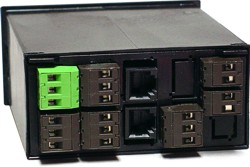
Key Features
- Meets 1/8 DIN Standard.
- Installs from front of panel.
- Short depth behind the panel: only 4" (102 mm) plus connectors.
- Understated 0.157" (4 mm) thick bezel.
- Meets NEMA 4X (IP-65) for high-pressure wawshdon when panel mounted.
- Screw clamps connectors meet VDE / IEC / UL / CSA safety standards.
- Rugged GE Lexan® housing material.
- Safety certified per EN 61010-1.
Dimensions
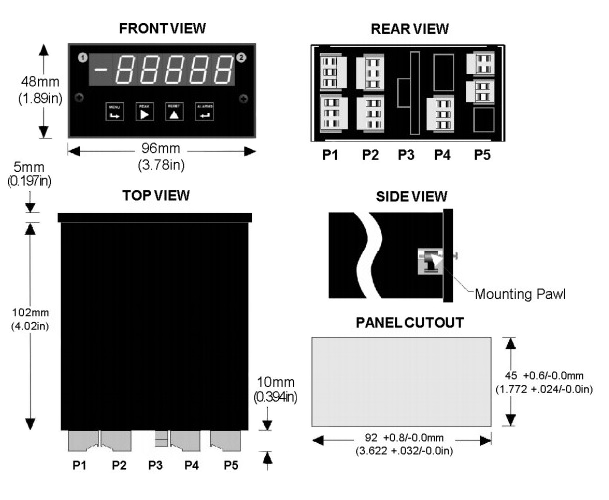
Maximum panel thickness: 4.5 mm (0.18")
Weight of base meter: 210 g (7.4 oz) typical (DPM, counter, timer, 6-digit remote display)
Weight of option boards: 30 g (1.0 oz) typical per board (analog output, relay output, communications)
Tightening Torque - Connectors: Screw terminal connectors: 5 lb-in (0.56 Nm)
Tightening Torque - Pawls: Digital Panel Meter Case Pawls: 5 lb-in (0.56 Nm)
Dimensioned CAD assembly drawings in EPRT, STEP, x_t. dwg, pdf file formats: Laureate-meter-case.zip (zipping prevents browser from opening CAD files as text files).
Panel Mounting
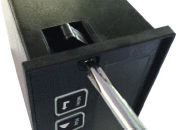 Slide the meter into a 45 x 92 mm 1/8 DIN panel cutout. Ensure that the provided gasket is in place between the front of the panel and the back of the meter bezel.
The meter is secured by two pawls, each held by a screw, as illustrated. Turning each screw counterclockwise extends the pawl outward from the case and behind the panel. Turning each screw clockwise further tightens it against the panel to secure the meter.
Slide the meter into a 45 x 92 mm 1/8 DIN panel cutout. Ensure that the provided gasket is in place between the front of the panel and the back of the meter bezel.
The meter is secured by two pawls, each held by a screw, as illustrated. Turning each screw counterclockwise extends the pawl outward from the case and behind the panel. Turning each screw clockwise further tightens it against the panel to secure the meter.
Turning each screw counterclockwise loosens the pawl and retracts it into its well. This position allows installed meter to be removed from their panel, or new meters to be installed in a panel. Do not remove the screws from their pawls. Doing so would cause the screw and pawl to fall off and likely get lost. Do not overtighten so as not to damage the plastic parts.
| Drum Filling Application Utilizing Two Relay Outputs | |
|---|---|
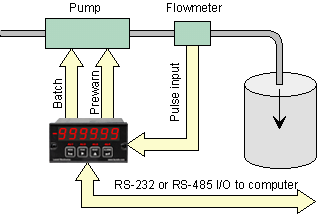 |
In this drum filling application, the Laureate pulse-input batch controller utilizes uses its two relays to control a pump. The Prewarn relay slows down the pump near the preset to avoid overshoot. The Batch relay stops the pump at the preset. |
| Controlling Chemical Mixing of Materials | |
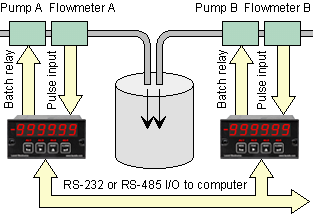 |
Multiple Laureate batch controllers can be used in combination to control the mixing of materials in the proper ratio. Each feed line is equipped with its own pump, flowmeter, and Laureate. Controller setup and monitoring of the mixing operation are facilitated by optional serial communications. RS485 allows a single data line to handle multiple controllers. |
| Up-Counting Batch Control | |
 |
In up-counting batch control, the Laureate counts up from zero to a preset maximum. A prewarn level is available to slow down filling near the preset to avoid overshoot. A time delay can be programmed from the end of each batch to the start of the next batch. |
| Down-Counting Batch Control | |
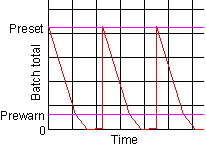 |
In down-counting batch control, the Laureate counts down from the preset maximum to zero. A prewarn level is available to slow down filling or emptying near zero. Again, a time delay can be programmed from the end of each batch to the start of the next batch. |
| Discrete Filling and Batch Counting | |
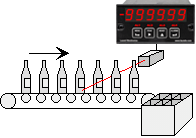 |
The Laureate batch controller is ideal for discrete manufacturing as well as repetitive fill operations. In this example, the Laureate counts bottles which it then groups into sixpacks. Its Grand Total capability can be used to track bottles or sixpacks. |
Batch Controller Digital Panel Meter Frequently Asked Technical Questions
IPC
Splashproof Cover
CLB01
RS232 Cable for Meters
CLB02
USB-to-RS232 Adapter Cable
CBL04
RS232 Cable for LT Transmitters
CLB05
USB Data Cable for Meters
CLB06
USB-to-RS485 Adapter Cable
CLB07
USB Programming & Data Cable
CLB08
RS485 Splitter Cable
BKBD
RS485 RJ11 Terminal Block Adapter
1/8 DIN Digital Panel Meter for Batch Controller Pulse Input
What is a 1/8 DIN Digital Panel Meter for Batch Controller Pulse Input?
A 1/8 DIN digital panel meter is a compact, standardized instrument used primarily for displaying and controlling various process variables in industrial and commercial applications. The term "1/8 DIN" refers to the meter's size, which is standardized by the Deutsches Institut für Normung (DIN), the German Institute for Standardization. The 1/8 DIN size corresponds to a front panel dimension of 96mm x 48mm (3.78 inches x 1.89 inches), making it a versatile choice for panel installations where space is at a premium.
When this digital panel meter is designed for batch controller pulse input, it means the device is specifically engineered to work with pulse signals for controlling batch processes. Here's a deeper dive into what this entails:
Understanding Digital Panel Meters
A digital panel meter is an electronic device that receives input signals from various sensors, transducers, or process equipment and displays the corresponding measurements on a digital screen. These inputs can be in the form of voltage, current, resistance, temperature, frequency, or pulses, depending on the specific application.
Batch Controllers: Role and Functionality
Batch controllers are specialized devices used in process automation to precisely control the amount of material, such as liquids, powders, or granules, that is dispensed into a container or process. The process typically involves filling, dosing, or mixing operations. A batch controller ensures that the correct quantity of material is delivered in each batch, helping to maintain consistency, reduce waste, and improve overall efficiency.
Pulse Input: How It Works
Pulse input refers to the method by which the digital panel meter receives information. In a pulse input system, the signal is provided in the form of pulses, where each pulse represents a specific quantity or event. For example:
- Flow Meters: Each pulse might represent a fixed volume of liquid or gas passing through a flow meter.
- Tachometers: Pulses could indicate the number of revolutions of a motor shaft.
The 1/8 DIN digital panel meter interprets these pulses and displays the corresponding value, such as total volume, flow rate, or batch count.
Key Features of a 1/8 DIN Digital Panel Meter for Batch Controller Pulse Input
-
Compact Design: The 1/8 DIN size is ideal for applications where space is limited but precise control is required.
-
Pulse Signal Compatibility: These meters are designed to work with pulse signals, making them suitable for applications like flow measurement, counting operations, and speed monitoring.
-
Accurate Measurement: The digital panel meter converts the pulse input into a digital readout, ensuring accurate measurement and control of the batch process.
-
Programmable Functions: Many models come with programmable setpoints, alarms, and output relays, allowing for flexible control over batch processes.
-
User-Friendly Interface: With a clear digital display and intuitive controls, operators can easily monitor and adjust batch parameters.
-
Industrial-Grade Durability: Built to withstand harsh industrial environments, these meters are rugged and reliable.
Applications of a 1/8 DIN Digital Panel Meter for Batch Controller Pulse Input
- Manufacturing: Controlling the precise amount of raw material dispensed in production lines.
- Water Treatment: Monitoring and controlling the flow of water or chemicals in treatment plants.
- Food and Beverage: Ensuring consistent batching of ingredients in food processing.
- Pharmaceuticals: Maintaining accurate dosing in drug manufacturing.
Where is a 1/8 DIN Digital Panel Meter for Batch Controller Pulse Input Used?
A 1/8 DIN digital panel meter is a versatile and compact instrument often employed in various industrial and commercial applications. When equipped with a batch controller and pulse input, this device becomes a powerful tool for process automation and control. In this article, we will explore the typical environments and use cases where a 1/8 DIN digital panel meter with a batch controller and pulse input is utilized.
1. Industrial Manufacturing
In manufacturing environments, precise control over the production process is crucial. A 1/8 DIN digital panel meter with batch controller and pulse input is often used to monitor and control the dispensing of raw materials, liquids, or components. For example, in a bottling plant, the device can be programmed to release a specific volume of liquid into each bottle. The pulse input allows the meter to count the number of pulses generated by flow meters or other sensors, ensuring accuracy in the batching process.
2. Chemical Processing
Chemical plants require precise measurement and control of ingredients to maintain product consistency and safety. The 1/8 DIN digital panel meter can be integrated into a system where it controls the release of chemicals based on pulse inputs from flow sensors. This ensures that the correct quantity of each chemical is mixed, preventing costly errors and enhancing product quality.
3. Water Treatment Facilities
In water treatment facilities, the accurate measurement and control of chemical additives are essential for maintaining water quality. A 1/8 DIN digital panel meter with batch controller pulse input can be used to regulate the dosing of chemicals like chlorine or fluoride. The pulse input feature allows the meter to receive signals from flow sensors, ensuring that the correct amount of chemical is dispensed in relation to the water flow.
4. Food and Beverage Industry
The food and beverage industry relies heavily on precision to maintain quality and compliance with health regulations. In this sector, a 1/8 DIN digital panel meter can be used for tasks such as portion control, where it ensures that the exact quantity of ingredients is added during production. For example, in a bakery, the meter can control the release of dough, ensuring consistency in product size and weight.
5. Pharmaceutical Manufacturing
Pharmaceutical manufacturing demands exact measurements to ensure the efficacy and safety of medicines. The 1/8 DIN digital panel meter is often used in the production of drugs to control the quantity of ingredients added to each batch. With pulse input capabilities, the meter can receive signals from precise flow meters or other sensors, ensuring that each batch is consistent with the required specifications.
6. Petrochemical Industry
In the petrochemical industry, where the handling of volatile and expensive materials is common, precision is paramount. A 1/8 DIN digital panel meter can be used to control the batching of fuels, lubricants, or other chemicals. The pulse input feature allows the meter to count pulses from flow sensors, enabling accurate measurement and control in the distribution of these materials.
7. Packaging Industry
The packaging industry often requires precise control over the quantity of product dispensed into containers. A 1/8 DIN digital panel meter with batch controller and pulse input is ideal for applications such as filling machines, where it can control the amount of liquid or solid product dispensed based on the pulse signals received from sensors. This ensures that each package contains the correct amount of product, reducing waste and ensuring customer satisfaction.
8. Energy Management Systems
In energy management systems, particularly those dealing with the distribution of electrical power or other forms of energy, accurate measurement is critical. A 1/8 DIN digital panel meter can be used to monitor and control the distribution of energy by counting pulses from energy meters or sensors. This ensures that energy is distributed efficiently and according to the requirements of the system.
Conclusion
A 1/8 DIN digital panel meter for batch controller pulse input is a crucial tool in process automation, providing precise control and monitoring of batch processes. Its compact size, pulse signal compatibility, and programmable features make it an ideal choice for a wide range of industrial applications, helping to improve efficiency, reduce waste, and ensure consistent quality in production.
Less Information.








